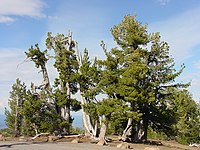
Photo from wikipedia
Dispersal of whitebark pine (Pinus albicaulis Engelm.), a keystone species of many high-elevation ecosystems in western North America, depends on Clark’s nutcracker (Nucifraga columbiana Wilson), a seed-caching bird with an… Click to show full abstract
Dispersal of whitebark pine (Pinus albicaulis Engelm.), a keystone species of many high-elevation ecosystems in western North America, depends on Clark’s nutcracker (Nucifraga columbiana Wilson), a seed-caching bird with an affinity for whitebark seeds. To the extent that this dependence is mutual, declines in whitebark seed production could cause declines in nutcracker abundance. Whitebark pine is in decline across much of its range due to interacting stressors, including the non-native pathogen white pine blister rust (Cronartium ribicola J. C. Fisch.). We used avian point-count data and tree surveys from four national park units to investigate whether trends in whitebark pine can explain trends in Clark’s nutcracker. Spatial trends were modeled using recent data from two parks, while temporal trends were modeled using longer time-series of nutcracker and whitebark data from two additional parks. To assess the potential dependence of nutcrackers on whitebark, we linked a model of nutcracker density (accounting for detection probability) with a model of whitebark trends, using a Bayesian framework to translate uncertainty in whitebark metrics to uncertainty in nutcracker density. In Mount Rainier National Park, temporal models showed dramatic declines in nutcracker density concurrent with significant increases in whitebark crown mortality and trees infected with white pine blister rust. However, nutcrackers did not trend with whitebark metrics in North Cascades National Park Service Complex. In spatial models of data from Yosemite National Park and Sequoia-Kings Canyon National Park, nutcracker density varied not only with local cover of whitebark but also with elevation and, in Sequoia-Kings Canyon, with cover of another species of white pine. Our results add support for the hypothesis that the mutualism between whitebark pine and Clark’s nutcracker is vulnerable to disruption by blister rust, and our approach integrates data across monitoring programs to explore trends in species interactions.
Journal Title: PLoS ONE
Year Published: 2020
Link to full text (if available)
Share on Social Media: Sign Up to like & get
recommendations!